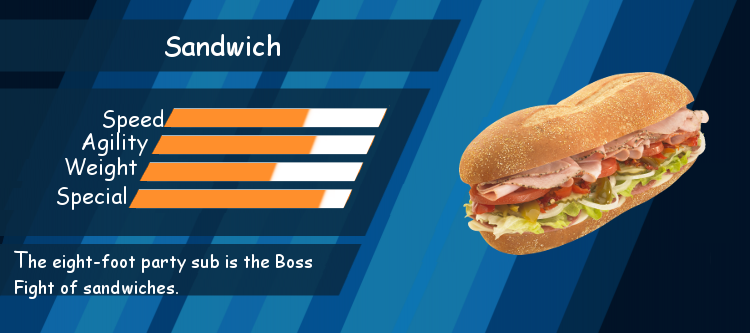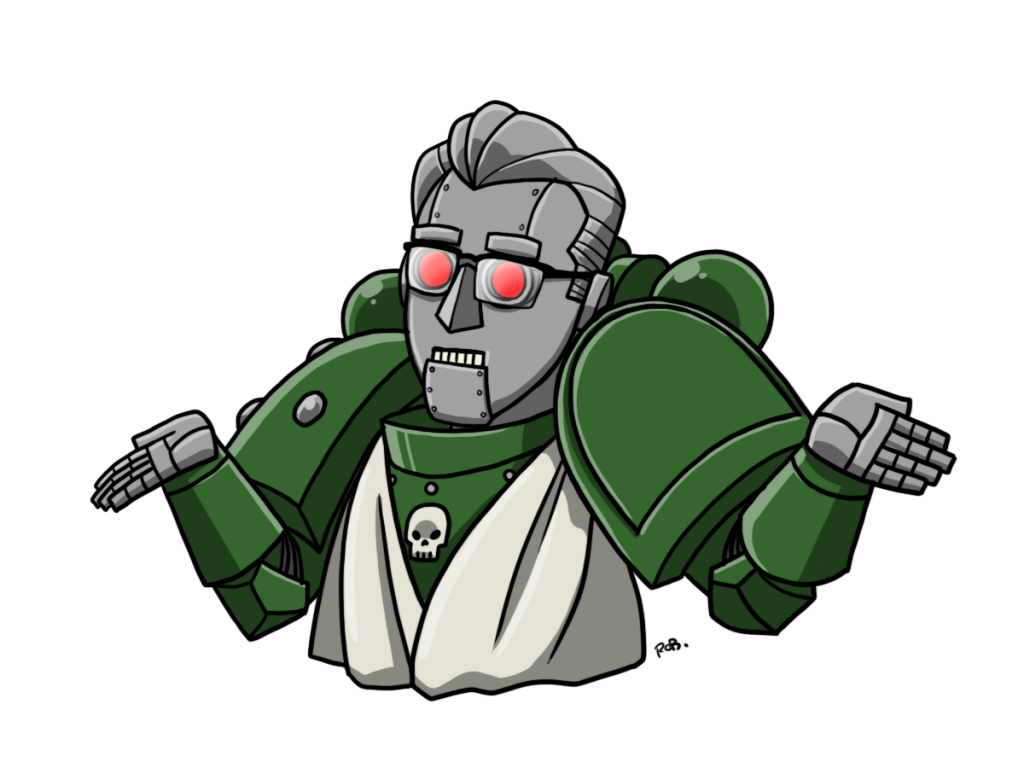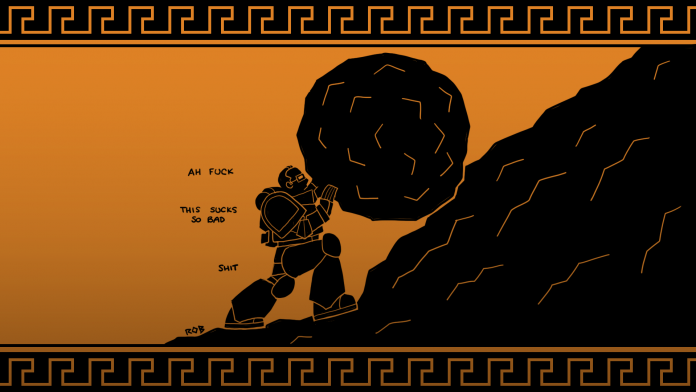There are two phrases I find myself repeating throughout the day. Not as an intrusive thought thing – those are more of a “cop rockets out of slide” nature this week, and they rotate out somewhat regularly – but as mantras: “I got enough problems, I don’t need this” and, shortly after, its corollary, a resigned “you gotta do what you gotta do”. The fact that I’m leaning on those two aphorisms so hard should serve to explain the prodigious drop in my hobby, gaming, and writing output over the past year or so. There’s a reason Meatwatch has been in the hands of irregular guest contributions for so long, is what I mean.
With the US Goonhammer Open coming up, I’ve added a new item to my list: getting back into the tournament grindset. I don’t have problems, I’m normal, but maybe you do. In that event, I think this worldview – I don’t want to do stuff, but I guess I have to – may provide a useful structure to cope with massive upheavals and crises in life, such as not having electricity for most of a week (tell my power company to go straight to hell), or playing Warhammer. This is a story about one game, but it’s also a story about every game.
We begin then, at the beginning. It’s not about getting good, but about understanding why you are bad. The point isn’t to minimize the number of things that are wholly beefed up, it’s to minimize the amount of things that are even slightly beefed. A partial problem occupies nearly the same volume as a complete one, and the bounds of how much we can handle are defined as much by the number of individual items as they are the total weight of them. Every little stupid thing is still Some Shit One Has Gotta Figure Out, and even if the individual cognitive load is minor it does compound. To put it another way, I learned playing Counter-Strike a million years ago that if you’re camping the hallways in de_dust, it’s not about how far away you can potentially see someone coming, it’s about how close they can get without being spotted. It sounds like the same concept, but it isn’t. Don’t worry about the most-distant point you can see, start with worrying about the closest point you can’t. Less optimization, and more survival.
Here are some Pro Tips, which you may find useful.
A Reasonable Luncheon

This fractal badness starts at a base level: perhaps I am simply built different (negative connotation). Perhaps it was a mistake to order and consume a humongous burrito before heading to the game store. I don’t want to point fingers here, but it bears some consideration that I’m no longer physically capable of absolutely going to town on a burrito that was made using a tortilla the size of a trash can lid and lumbering across a parking lot in 95 degree heat, while still holding in reserve enough energy to behave in a Warhammer-like way. Until the venue offers a fainting couch, this is step one: don’t do that. Eating too big of a lunch could be your Achilles’ heel. There’s little one can do about a fragile constitution, but a reasonable lunch and comfortable shoes are a good start.
What is a Warhammer, and How Does it Work?
Before playing it, I had read the core rules for Warhammer 40,000 10th edition precisely zero times (I bought the rulebook immediately before reserving a table, and didn’t open it until turn 2). Now I have read them one time. I will likely do so again, and maybe even flip through the Tactical Objectives cards in advance, instead of when I draw them. There’s a lot to get used to, and it’s been a while since the last time I had to deal with edition churn, so I’d forgotten how insidious the changes around the edges could be – literally, in the case of terrain, but figuratively in others. When you roll up to the table at an event, you’ll have enough trouble trying to play 5 turns in two and a half hours against a skilled and motivated opponent, and the last thing you need is to be learning the game during it. Minimize your attack surface by having some idea of the game – meaning a set of mechanics and probabilities – so you can focus on the game – meaning the specific instance of Warhammer taking place in front of you. The main things I’d worry about would be terrain and how it interacts with line of sight and cover, since those tend to catch people out, but in tenth Rapid Ingress and Overwatch are “fun” new wrinkles.
There’s no easy way to cheat on this one: you gotta crack a book like some kind of nerd. To assist with this, there’s a ton of information and analysis right here on Goonhammer, but either I didn’t read it or I did and didn’t remember it, because my brain has been polished to a smooth orb from Posting too hard. Maybe I should remember things better, but maybe it’s a little late for you to be giving me that advice buddy, so scram. My skull contains mostly air and a brain like a small glob of liquid mercury, sloughing off any stray facts that it was unable to dance away from.
Your Army Sucks

Your other problem is getting to grips with your list. I’ve used units that could infiltrate, but didn’t, because I failed to notice the keywords. I’ve completely stumped myself on capturing the center objective, despite having a unit of battlesuits that were capable of advancing 18”, shooting, and moving another 12”, because I simply forgot I could do that. Army problems come down to two main sorts: the amount of units in the army, and the amount of rules on each unit. The volume of Warhammer and the density of it. Incidentally, if you’re wondering why I’m such a stickler for WYSIWYG, this is why. I’m straight up too dumb to remember what things are unless I can look at the model and check. One day I’m going to be playing peekaboo with my toddler, and I am going to lose.
As a way of limiting my problem scope here, reducing the amount of data sheets considerably compared to my Dark Angels, and as a bonus indulging in a deep love of mecha, I’ve decided to focus on playing T’au Empire for the time being. I’ve deferred to reality on one other point: I’m realistically not going to be buying or painting new models any time soon, so I won’t trouble myself with things like Shadowsun or Cyclic Ion Blasters, models that I do not currently own. It doesn’t matter how good they are, I’m not taking them. Won’t be paying attention. Kroot simply do not exist, to me.
By cutting down on the number of units you have to worry about, you have slightly reduced the number of problems you can have, and also drastically reduced the number of solutions available. This is obviously bad, but it’s also realistic, the Least Army Principle applied. Having only six stratagems to worry about is a boon to players like me, but it turns out that you can also ignore half of them and only have to juggle three, by building an army poorly enough. That just leaves the in-game behavior to worry about, which presents a thornier and more intractable problem.
What Are the Haps, My Friend?
The radiant molten core of Planet Cretin, where I live (I hate it here): the game plan. Personally, I have precisely one, and will apply it to every game regardless of opponent or mission: avoid getting punched to death, fire railguns where possible, and do whatever the random cards tell me. Picking fixed secondaries offers only the potential to pick wrong, and I’d rather trust in the heart of the cards than my own abilities. You’re going to want to go fixed into Knights (either type) and take Bring it Down, but consider before doing this what you want your other secondary to be. If you aren’t built for Engage or something, you might be better off just sticking with Tactical. Let the cards do the work of figuring it out. There are two different ways to discard cards, one costing a CP and one gaining a CP, but check it out: don’t bother with that. Can’t get the rules wrong if you just ignore them!
The one time I tried to implement my plan, it might have worked, except I kept thinking of what I was going to do, saying out loud that I was going to do it, and then not doing it. Case in point, I drew Bring It Down against Chaos Knights. This is normally a great pull. It may not be an automatic 8 points, but if you can’t find a way to maximize that objective against that army, you are never going to succeed having drawn any card in your entire life. I said – again, out loud – that instead of harmlessly pinging half the wounds off the Tyrant in the center, I would instead knock down a couple of Wardogs and score easy points.
Halfway through my shooting phase, I started shooting at the Tyrant again. I do not know why. Was I mad at it? Was the grande burrito (big burrito) coming back for another round, doing whatever it is that much cheese does to your blood? Realistically, even if I had blown the thing up – and I did not – it wasn’t going to be worth more than knocking out two smaller knights, a thing I also did not do. I didn’t even notice it happening at the time, and to my opponent’s credit he didn’t stop me, he just let me do it and asked why later. This was the correct play, because I was in the process of learning a Life Lesson, and that doesn’t sink in unless you suffer consequences: we can forget the pain, until the scars remind us.
Do What You Want, Because You’re Gonna Anyway

We’re coming up on three full pages now, of something that a more cynical or clear-eyed reader would boil down to just the words “skill issue”, but this is more than just completing steps 4 and 5. Yes, it’s a fearless moral inventory and a form of admitting my past wrongs, but it’s also a statement of intent, one that any player of any game can use if they want. It might feel like I’m reading too much into one instance here, of a game I’m somehow still learning despite playing for a decade and part-owning a successful media company centered on it, but there’s a pattern that cuts across all editions of Warhammer, and in fact transcends Warhammer.
A game is just a set of events that occur. Some of them prompt decisions being made (in the remainder your choice boils down to “Elves? pick up some models and continue on, or pick up all your models and concede the game“, which is only technically a choice). If you choose correctly enough, you get a little trophy and get to go home filled with the joy of life. If you don’t, it feels like you just got done working a double at the Getting Your Hand Stuck In A Car Door factory. Sometimes (Eldar) there isn’t much you can do either way, so just roll with it and take the L, but most of the time there are things you can do if you understand the tools at your disposal and – this is key – you don’t get into Feeling Your Feelings about it and giving up on a winnable game. I’m not saying it’s always easy to tell in the moment which is the case, but it’s far more common to see folks getting tilted or sloughing into defeatism in what is still a winnable game, than to see them dig deep and will themselves back into contention. You’re gonna do what you’re gonna do, but I think there’s some merit to not collapsing into a weepy mess just because you lost a unit or biffed a charge. Give it a shot! You might just learn something.
I’m not good at this. I’m not going to be good at this. Maybe I’m not even going to be a little less bad. But at least next time I’ll know a little more about the how and why and what of it. The train hits you just as hard whether you see it coming or not, but if you can perceive even just a little glimpse of how truly screwed you’re about to be, there may be a chance you can do something about it, even if it’s just to brace for impact. That’s a sort of hope.
The Goonhammer Open US GT will be held on August 19th and 20th in Baltimore, a city I dearly love even though it objectively sucks. I hope to see you there. I doubt this article will prove helpful to anyone.
I’ll most likely be back next week with a woeful tale of how disastrously my games went. In the mean time, let us know in the comments or on various of Socials Medium whether you want to see less of this sort of thing.


